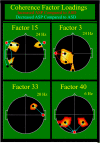The relationship of Asperger's syndrome to autism: a preliminary EEG coherence study
- PMID: 23902729
- PMCID: PMC3729538
- DOI: 10.1186/1741-7015-11-175
The relationship of Asperger's syndrome to autism: a preliminary EEG coherence study
Abstract
Background: It has long been debated whether Asperger's Syndrome (ASP) should be considered part of the Autism Spectrum Disorders (ASD) or whether it constitutes a unique entity. The Diagnostic and Statistical Manual, fourth edition (DSM-IV) differentiated ASP from high functioning autism. However, the new DSM-5 umbrellas ASP within ASD, thus eliminating the ASP diagnosis. To date, no clear biomarkers have reliably distinguished ASP and ASD populations. This study uses EEG coherence, a measure of brain connectivity, to explore possible neurophysiological differences between ASP and ASD.
Methods: Voluminous coherence data derived from all possible electrode pairs and frequencies were previously reduced by principal components analysis (PCA) to produce a smaller number of unbiased, data-driven coherence factors. In a previous study, these factors significantly and reliably differentiated neurotypical controls from ASD subjects by discriminant function analysis (DFA). These previous DFA rules are now applied to an ASP population to determine if ASP subjects classify as control or ASD subjects. Additionally, a new set of coherence based DFA rules are used to determine whether ASP and ASD subjects can be differentiated from each other.
Results: Using prior EEG coherence based DFA rules that successfully classified subjects as either controls or ASD, 96.2% of ASP subjects are classified as ASD. However, when ASP subjects are directly compared to ASD subjects using new DFA rules, 92.3% ASP subjects are identified as separate from the ASD population. By contrast, five randomly selected subsamples of ASD subjects fail to reach significance when compared to the remaining ASD populations. When represented by the discriminant variable, both the ASD and ASD populations are normally distributed.
Conclusions: Within a control-ASD dichotomy, an ASP population falls closer to ASD than controls. However, when compared directly with ASD, an ASP population is distinctly separate. The ASP population appears to constitute a neurophysiologically identifiable, normally distributed entity within the higher functioning tail of the ASD population distribution. These results must be replicated with a larger sample given their potentially immense clinical, emotional and financial implications for affected individuals, their families and their caregivers.
Figures



References
-
- Baio J. Prevalence of Autism Spectrum Disorders — Autism and Developmental Disabilities Monitoring Network, 14 Sites, United States, 2008. Atlanta, GA: Center for Disease Control; 2012. - PubMed
-
- American Psychiatric Association. Diagnostic and Statistical Manual of Mental Disorders Fourth Edition Text Revision (DSM-IV-TR) Washington, DC: American Psychiatric Publishing, Inc; 2000.
-
- Wing L. Asperger’s syndrome: a clinical account. Psychol Med. 1981;11:115–129. - PubMed
-
- Asperger H. In: Autism and Asperger Syndrome. Frith U, editor. Cambridge, UK: Cambridge University Press; 1991. Autistic psycopathy in childhood; pp. 37–92.
-
- Gillberg IC, Gillberg C. Asperger syndrome - some epidemiological considerations: a research note. J Child Psychol Psychiatr. 1989;30:631–638. - PubMed
Publication types
MeSH terms
Grants and funding
LinkOut - more resources
Full Text Sources
Other Literature Sources

